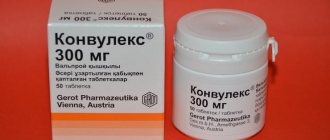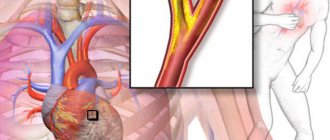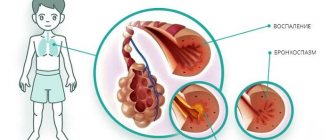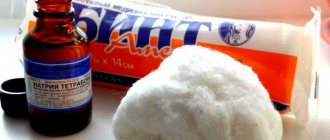Pharmacological properties of the drug Convulex injection solution
Pharmacodynamics. Sodium valproate increases the content of GABA in the brain, which correspondingly leads to an increase in the content of GABA in postsynaptic neurons. In addition, sodium valproate affects the transport of potassium ions across neuronal membranes. The result of this influence is the suppression of the occurrence and spread of epileptic excitation along neurons. Sodium valproate has anticonvulsant activity in various types of epilepsy. The drug does not have a pronounced hypnotic or sedative effect, as well as a depressant effect on the respiratory center. Does not have a negative effect on blood pressure, heart rate, kidney function and body temperature. Pharmacokinetics. With intravenous administration, the therapeutic concentration of the drug in the blood serum is achieved in the first minutes; if necessary, it can be maintained at the required level using infusion. Approximately 90–95% of valproic acid is bound to plasma proteins, predominantly albumin; the degree of binding decreases when administered at higher doses. In elderly patients and in patients with liver or kidney failure, the degree of binding of the drug to plasma proteins is much lower. Biotransformation occurs through glucuronidation and beta, omega and omega-1 oxidation. Approximately 20% of the dose is excreted by the kidneys as a glucuronide ester, ≤5% is excreted unchanged in the urine.
Use of the drug Convulex solution for injection
The daily dose of the drug is selected individually, taking into account age, body weight and sensitivity to sodium valproate. If there is no significant correlation between the daily dose, serum concentration and therapeutic effect, the optimal dose should be adjusted based on the clinical effect. If an adequate therapeutic effect cannot be achieved or side effects of therapy occur, the level of valproate in the blood plasma should be determined and clinical indicators monitored. The effective concentration in blood plasma ranges from 40 to 100 mg/l (300–700 µmol/l). The dose for slow intravenous administration is 5–10 mg/kg body weight. In middle-aged patients weighing 65 kg, this is approximately 500 mg of sodium valproate, or the contents of 1 ampoule. If there is a need to use the drug in the form of an intravenous infusion, the recommended rate of administration is 0.5–1 mg/kg/h. In cases where it is necessary to quickly achieve and maintain a high concentration of the drug in the blood plasma, the following administration regimen is recommended: intravenous administration of sodium valproate at a dose of 15 mg/kg over 5 minutes, after 30 minutes begin an infusion of sodium valproate at a rate of 1 mg/kg. kg/h under the control of plasma concentration (to achieve a level of 75 mcg/ml). For proper dose selection, the clinical condition of the patient should be taken into account. If repeated injection or infusion of sodium valproate is necessary, the maximum daily dose should not exceed 2500 mg. Children, including infants over 2 months of age, should first be prescribed the drug orally (usually at a dose of 20–30 mg/kg/day), and then given intravenous injections or infusion at a rate of 0.8–1.35 mg/day. kg/h. If it is necessary to transfer the patient from oral to injection or infusion administration of the drug, the dose ratio should be 1:1. IV administration should begin 12 hours after the last oral dose. The maximum daily dose for intravenous administration is 2500 mg. Recommended average daily doses of sodium valproate: • for middle-aged and elderly people - 20 mg/kg; • for adolescents - 25 mg/kg; • for children - 30 mg/kg. The solution for infusion is prepared at the rate of: the contents of 1 ampoule (500 mg of sodium valproate) per 500 ml of infusion solution. The prepared solution is administered at a rate of 1 ml/kg/h. To prepare an infusion solution of sodium valproate, it is necessary to use the following solutions: isotonic solution of sodium chloride; 5% glucose solution; Lactated Ringer's solution. The injection solution should be administered slowly (over approximately 3–5 minutes), IV only, or used as an infusion (to continue therapy or for repeated administration). Cannot be administered simultaneously with other solutions for intravenous administration. Only transparent, colorless or slightly yellowish solution is suitable for use.
Convulex 100mg/ml 5ml 5 pcs. injection solution for intravenous administration
pharmachologic effect
Pharmacological action: antiepileptic.
Composition and release form Convulex 100 mg/ml 5 ml 5 pcs. injection solution for intravenous administration
Solution for intravenous administration 100 mg/ml 5 ml (1 amp.):
- active substance: sodium valproate - 500 mg (equivalent to valproic acid 433.9 mg);
- excipients: sodium hydroxide - 117 mg; sodium hydrogen phosphate dodecahydrate - 71.8 mg, water for injection - up to 5 ml.
Solution for intravenous administration, 100 mg/ml. 5 ml in a colorless glass ampoule (type I) with a red break point and an orange ring at the top. 5 amp. in a transparent plastic tray; 1 pallet in a cardboard box.
Description of the dosage form
Transparent colorless or almost colorless liquid.
Directions for use and doses
IV. With slow intravenous administration, the recommended daily dose of valproic acid is 5–10 mg/kg. For intravenous infusion, the recommended dose of valproic acid is 0.5–1 mg/kg/hour.
When switching from oral to intravenous administration, the dose is not changed; the first intravenous administration is recommended 12 hours after the last oral administration. The injection solution should be replaced by taking the drug orally as soon as the patient's condition allows it. The first oral administration is also recommended 12 hours after the last injection.
If it is necessary to quickly achieve and maintain high plasma concentrations, the following approach is recommended: intravenous administration of 15 mg/kg over 5 minutes, after 30 minutes, begin infusion at a rate of 1 mg/kg/h with constant monitoring of concentrations until a plasma level reaches about 75 µg/ml.
The maximum daily dose of the drug should not exceed 2500 mg.
Average daily doses are 20 mg/kg in adults and elderly patients, 25 mg/kg in adolescents, 30 mg/kg in children.
Isotonic sodium chloride solution, 5% dextrose solution, and Ringer's solution can be used as an infusion solution for the drug Convulex. The prepared solution for infusion can be used within 24 hours; the unused volume of the solution is destroyed. If other drugs are also used intravenously, the drug Convulex must be administered through a separate infusion system.
Pharmacodynamics
Konvulex is an antiepileptic drug that also has a central muscle relaxant and sedative effect. The mechanism of action is primarily due to an increase in GABA content in the central nervous system due to inhibition of the GABA transferase enzyme. GABA reduces the excitability and convulsive readiness of the motor areas of the brain. In addition, in the mechanism of action of the drug, a significant role is played by the effect of valproic acid on GABAA receptors (activation of GABAergic transmission), as well as the effect on voltage-gated sodium channels. According to another hypothesis, it acts on sites of postsynaptic receptors, simulating or enhancing the inhibitory effect of GABA. A possible direct effect on membrane activity is associated with changes in potassium conductance. Improves the mental state and mood of patients, has antiarrhythmic activity.
Pharmacokinetics
Css (equilibrium concentration) with IV (intravenous) administration is achieved within a few minutes and can be maintained with a slow infusion. The therapeutic concentration of valproic acid in blood plasma ranges from 50–150 mg/l. Valproic acid is bound to plasma proteins by 90–95% at plasma concentrations up to 50 mg/l and by 80–85% at concentrations of 50–100 mg/l; with uremia, hypoproteinemia and cirrhosis, binding to plasma proteins is reduced. The concentration in the cerebrospinal fluid correlates with the value of the non-plasma protein-bound fraction of valproic acid, accounting for about 10% of the serum level. Valproic acid penetrates the GPB and BBB and is excreted in breast milk. Concentrations in breast milk are 1–10% of maternal plasma concentrations. Valproic acid undergoes glucuronidation and oxidation in the liver, metabolites and unchanged valproic acid (1–3% of the dose) are excreted by the kidneys, small amounts are excreted in feces and exhaled air. T1/2 of valproic acid is in healthy subjects and with monotherapy from 8 to 20 hours; when combined with inducers of microsomal liver enzymes involved in the metabolism of valproic acid, T1/2 can be 6–8 hours; in patients with impaired liver function, elderly patients and children under 18 months - may be significantly longer.
Indications for use Convulex 100 mg/ml 5 ml 5 pcs. injection solution for intravenous administration
- status epilepticus;
- epilepsy of various etiologies - idiopathic, cryptogenic and symptomatic;
- generalized epileptic seizures in adults and children: clonic, tonic, tonic-clonic, absence seizures, myoclonic, atonic;
- partial epileptic seizures in adults and children: with or without secondary generalization;
- specific syndromes (West, Lennox-Gastaut);
- febrile seizures in children;
- treatment and prevention of bipolar affective disorders.
Contraindications
- hypersensitivity to valproic acid and its salts or components of the drug;
- liver failure;
- acute and chronic hepatitis;
- pancreatic dysfunction;
- porphyria;
- hemorrhagic diathesis;
- severe thrombocytopenia;
- combination with mefloquine, St. John's wort, lamotrigine;
- disorders of urea metabolism (including family history);
- lactation period.
With caution: children - when treated with several antiepileptic drugs; children and adolescents with multiple comorbidities and severe seizures; renal dysfunction; patients with anamnestic data on diseases of the liver and pancreas; inhibition of bone marrow hematopoiesis (leukopenia, anemia, thrombocytopenia); congenital enzymopathies; organic brain damage; hypoproteinemia; children's age (up to 3 years); pregnancy (especially the first trimester).
Application of Convulex 100 mg/ml 5 ml 5 pcs. injection solution for intravenous administration during pregnancy and breastfeeding
During treatment, pregnancy should be protected. Experiments on animals revealed the teratogenic effect of valproic acid. The incidence of neural tube defects in children born to women who took valproate in the first trimester of pregnancy is 1–2%. In this regard, it is advisable to use folic acid preparations. In the first trimester of pregnancy, treatment with Convulex should not be started. If a pregnant woman is already receiving the drug, treatment should not be interrupted due to the risk of increased seizures. The drug should be used in the lowest effective doses, avoiding combination with other anticonvulsants and, if possible, regularly monitoring the concentration of valproic acid in plasma.
Overdose
Symptoms: nausea, vomiting, dizziness, diarrhea, respiratory dysfunction, muscle hypotonia, hyporeflexia, miosis, coma.
Treatment: hemodialysis, forced diuresis, respiratory support and cardiovascular system.
Side effects Convulex 100mg/ml 5ml 5 pcs. injection solution for intravenous administration
In general, Konvulex is well tolerated by patients. Side effects are possible mainly when the concentration of valproic acid in plasma is above 100 mg/l or with combination therapy.
From the gastrointestinal tract: nausea, vomiting, gastralgia, decreased or increased appetite, diarrhea, hepatitis, constipation, pancreatitis, up to severe injuries with a fatal outcome (in the first 6 months of treatment, more often in the 2nd–12th week).
From the central nervous system: tremor, changes in behavior, mood or mental state (depression, feeling tired, hallucinations, aggressiveness, hyperactive state, psychosis, unusual agitation, restlessness or irritability), ataxia, dizziness, drowsiness, headache, encephalopathy, dysarthria, enuresis, stupor, impaired consciousness, coma.
From the senses: diplopia, nystagmus, flickering of spots before the eyes.
From the hematopoietic organs and hemostasis system: anemia, leukopenia, thrombocytopenia, decreased fibrinogen content and platelet aggregation, leading to the development of hypocoagulation (accompanied by prolonged bleeding time, petechial hemorrhages, bruises, hematomas, bleeding).
Metabolism: loss or increase in body weight.
Allergic reactions: skin rash, urticaria, angioedema, photosensitivity, malignant exudative erythema (Stevens-Johnson syndrome).
Laboratory indicators: hypercreatininemia, hyperammonemia, hyperglycinemia, hyperbilirubinemia, slight increase in the activity of liver transaminases, LDH (dose-dependent).
From the endocrine system: dysmenorrhea, secondary amenorrhea, breast enlargement, galactorrhea.
Other: peripheral edema, hair loss (usually restored after discontinuation of the drug).
Drug interactions
Contraindicated combinations
Mefloquine. The risk of epileptic seizures due to increased metabolism of valproic acid and a decrease in its concentration in plasma and, on the other hand, the anticonvulsant effect of mefloquine.
St. John's wort. The risk of a decrease in the concentration of valproic acid in the blood plasma.
Not recommended combinations
Lamotrigine. Increased risk of severe skin reactions (toxic epidermal necrolysis). Valproic acid inhibits microsomal liver enzymes that ensure the metabolism of lamotrigine, which slows down its T1/2 to 70 hours in adults and up to 45–55 hours in children and increases plasma concentrations. If the combination is necessary, careful clinical and laboratory monitoring is required.
Combinations requiring special precautions
Carbamazepine. Valproic acid increases the concentration of the active metabolite of carbamazepine in plasma to the point of overdose. In addition, carbamazepine enhances the hepatic metabolism of valproic acid and reduces its concentration. These circumstances require the attention of a doctor and determination of drug concentrations in plasma and a possible revision of their dosages.
Phenobarbital, primidone. Valproic acid increases plasma concentrations of phenobarbital or primidone to the point of signs of overdose, more often in children. In turn, phenobarbital or primidone enhance the hepatic metabolism of valproic acid and reduce its concentration. Clinical observation is recommended during the first 2 weeks of combined use with an immediate reduction in the dose of phenobarbital or primidone if signs of sedation appear, and determination of the level of antiepileptic drugs in the blood.
Phenytoin. Changes in the concentration of phenytoin in plasma are possible; phenytoin increases the hepatic metabolism of valproic acid and reduces its concentration. Clinical observation is recommended, determining the level of antiepileptic drugs in the blood, changing dosages if necessary.
Clonazepam. The addition of valproic acid to clonazepam in isolated cases can lead to increased severity of absence status.
Ethosuximide. Valproic acid can either increase or decrease the serum concentration of ethosuximide due to changes in its metabolism. Clinical observation is recommended, determining the level of antiepileptic drugs in the blood, changing dosages if necessary.
Topiramate. The risk of developing hyperammonemia and encephalopathy increases.
Felbamate. An increase in the concentration of valproic acid in plasma by 35–50% with the risk of overdose. Clinical observation, determination of the level of valproic acid in the blood, and changes in the dosage of valproic acid when combined with felbamate and after its discontinuation are recommended.
Neuroleptics, MAO inhibitors, antidepressants, benzodiazepines. Neuroleptics, tricyclic antidepressants, MAO inhibitors, which reduce the threshold for convulsive readiness, reduce the effectiveness of the drug. In turn, valproic acid potentiates the effect of these psychotropic drugs, as well as benzodiazepines.
Cimetidine, erythromycin. Suppress the hepatic metabolism of valproic acid and increase its concentration in plasma.
Zidovudine. Valproic acid increases the plasma concentration of zidovudine, which leads to increased toxicity.
Carbapenems, monobactams. Meropenem, panipenem, as well as aztreonam and imipenem reduce the plasma concentration of valproic acid, which may lead to a decrease in the anticonvulsant effect.
Combinations to consider
Acetylsalicylic acid. Strengthening the effects of valproic acid due to its displacement from plasma proteins. Valproic acid enhances the effect of acetylsalicylic acid.
Indirect anticoagulants. Valproic acid enhances the effect of indirect anticoagulants; careful monitoring of the prothrombin index is necessary when administered together with vitamin K-dependent anticoagulants.
Nimodipine. Strengthening the hypotensive effect of nimodipine due to an increase in its concentration in plasma due to the suppression of its metabolism by valproic acid.
Myelotoxic drugs. Increased risk of suppression of bone marrow hematopoiesis.
Ethanol and hepatotoxic drugs. Increase the likelihood of developing liver damage.
Other combinations
Oral contraceptives. Valproic acid does not induce liver microsomal enzymes and does not reduce the effectiveness of hormonal oral contraceptives.
Side effects of the drug Convulex injection solution
From the blood system: rarely - thrombocytopenia (especially in children), leukopenia, decreased blood clotting, which is accompanied by an increase in bleeding time, petechial hemorrhages, hematomas, bleeding, hypofibrinogenemia, eosinophilia, anemia. From the nervous system and sensory organs: possible headache, drowsiness, paresthesia, impaired consciousness, stupor, depression, feeling of fatigue, weakness, aggressive behavior, tremor, rarely - muscle spasms and ataxia, increased irritability, hyperactivity, hallucinations, tinnitus , encephalopathy. From the urinary system: enuresis. From the gastrointestinal tract: depending on the dose, there may be an increase or decrease in body weight, increased appetite or anorexia, nausea, vomiting, pain in the epigastric region, diarrhea and other dyspeptic disorders, impaired liver function (increased levels of liver transminases and bilirubin levels in the blood serum) and pancreas, pancreatitis. From the skin: photosensitivity, alopecia. Allergic reactions: skin rash, angioedema, necrotizing skin lesions with a fatal outcome (in older children when used for 6 months). Laboratory values: Possible increases in testosterone levels have been reported very rarely. Other: rarely - nonspecific pain and enuresis, mainly in children, the possibility of polycystic ovary syndrome. In addition, amenorrhea and other menstrual irregularities are possible. There are isolated reports of the development of Fanconi syndrome (metabolic acidosis, phosphaturia, aminoaciduria, glycosuria), which resolves after discontinuation of sodium valproate. When using sodium valproate in the form of an injection solution, transient nausea and drowsiness may occur immediately after administration of the drug.
Special instructions for the use of the drug Convulex solution for injection
When using sodium valproate, the level of transaminases, bilirubin, amylases and platelet counts in the blood should be regularly monitored (every 3 months). The drug inhibits platelet aggregation, which can cause prolongation of blood clotting time during bleeding. The possibility of developing hemorrhagic complications in the postoperative period in patients using sodium valproate should be taken into account. With prolonged use of the drug, the development of hematomas and bleeding is possible. In such cases, the drug should be discontinued immediately. Sodium valproate can cause the development of drug-induced pancreatitis and liver dysfunction (especially in the first 6 months of use), therefore, during this period it is necessary to regularly monitor the functional state of the pancreas and liver, and prothrombin levels. Impaired liver function and liver failure during therapy with sodium valproate sometimes develops in children with epilepsy and concomitant metabolic and degenerative diseases, organic brain pathology and delayed mental development. Treatment with sodium valproate should be stopped by gradually reducing the dose, monitoring the EEG, the parameters of which should not deteriorate. When reducing the dose of the drug in children, body weight and age characteristics should be taken into account. Prescribing the drug during pregnancy is possible only if the potential benefit to the mother outweighs the potential risk to the fetus. During pregnancy, the use of sodium valproate should not be interrupted without clear medical indications, since sudden cessation of use or a sharp reduction in the dose of the drug can cause epileptic seizures in a pregnant woman, which can cause significant harm to the mother and fetus. Women of childbearing potential should be informed of the need to use contraceptive measures before initiating valproate therapy. There are reports of the development of hemorrhagic syndrome in newborns whose mothers took valproate during pregnancy. The development of the syndrome is associated with hypofibrinogenemia, which can lead to decreased blood clotting. This syndrome should be differentiated from folic acid deficiency. It is necessary to monitor the platelet index, fibrinogen levels and blood coagulation factors in newborns whose mothers took the drug. Valproate crosses the placental barrier and reaches higher concentrations in fetal blood than in maternal blood. Sodium valproate is excreted into breast milk. At dynamic equilibrium, the concentration of valproate in breast milk is approximately 10% of the serum concentration. It is recommended to discontinue breast-feeding while using sodium valproate. Sodium valproate should be used with caution in children requiring additional antiepileptic drugs; in children and adolescents with concomitant diseases and mental disorders; with bone marrow damage; for enzymopathy: for hypoproteinemia; with systemic lupus erythematosus. Sodium valproate weakens attention and has a slight sedative effect, so you should be careful when working with machinery and refrain from driving during treatment.
Convulex®
Due to reports of severe and fatal cases of liver failure and pancreatitis when using valproic acid preparations, the following should be kept in mind:
— a high-risk group includes infants and children under 3 years of age with severe epilepsy, often associated with brain damage and congenital metabolic or degenerative diseases;
- in most cases, liver dysfunction developed in the first 6 months (usually between 2 and 12 weeks) of treatment, more often with combined antiepileptic treatment;
- cases of pancreatitis were observed regardless of the patient’s age and duration of treatment, although the risk of developing pancreatitis decreased with the patient’s age;
— insufficiency of liver function in pancreatitis increases the risk of death;
- early diagnosis (before the icteric stage) is based mainly on clinical observation - identification of early symptoms such as asthenia, anorexia, extreme fatigue, drowsiness, sometimes accompanied by vomiting and abdominal pain; in this case, a relapse of epileptic seizures may occur against the background of unchanged antiepileptic therapy.
In such cases, you should immediately consult a doctor for a clinical examination and liver function test.
During treatment, especially in the first 6 months, it is necessary to periodically check liver function - liver transaminase activity, levels of prothrombin, fibrinogen, coagulation factors, bilirubin concentration, as well as amylase activity (every 3 months, especially when combined with other antiepileptic drugs) and picture of peripheral blood, in particular blood platelets.
In patients receiving other antiepileptic drugs, transfer to valproic acid should be carried out gradually, reaching a clinically effective dose after 2 weeks, after which gradual withdrawal of other antiepileptic drugs is possible. In patients not treated with other antiepileptic drugs, a clinically effective dose should be achieved after 1 week.
The risk of side effects from the liver is increased during combination anticonvulsant therapy, as well as in children. Drinks containing ethanol are not allowed.
Before surgery, a general blood test (including platelet count), determination of bleeding time, and coagulogram parameters are required.
If symptoms of an “acute” abdomen occur during treatment, before surgery, it is recommended to determine the activity of amylase in the blood to exclude acute pancreatitis.
During treatment, one should take into account the possible distortion of the results of urine tests in diabetes mellitus (due to an increase in the content of ketone bodies) and indicators of thyroid function.
If any acute serious side effects develop, you should immediately discuss with your doctor the advisability of continuing or stopping treatment.
To reduce the risk of developing dyspeptic symptoms, it is possible to take antispasmodics and enveloping agents.
Abruptly stopping taking Convulex may lead to an increase in epileptic seizures.
Impact on the ability to drive vehicles and operate machinery
During the treatment period, care must be taken when driving vehicles and engaging in other potentially hazardous activities that require increased concentration and speed of psychomotor reactions.
Interactions of the drug Convulex solution for injection
Before starting intravenous administration of sodium valproate simultaneously with other antiepileptic drugs, their plasma concentrations should be determined in order to adjust the individual dose of orally taken antiepileptic drugs. Phenobarbital, primidone, phenytoin and carbamazepine, when used simultaneously with sodium valproate, accelerate its elimination from the body and reduce its level in the blood plasma, which can lead to a decrease in the effectiveness of sodium valproate therapy. Mefloquine, when used in combination, accelerates the metabolism of sodium valproate and can cause the development of epileptic seizures. With simultaneous use of cimetidine and erythromycin, the concentration of valproate in the blood plasma may increase (due to a decrease in its metabolism in the liver). With the combined use of sodium valproate with panipenem and meropenem, the concentration of sodium valproate in the blood serum decreases, which can lead to the development of epileptic seizures. In case of simultaneous use of sodium valproate and drugs that bind to blood proteins (acetylsalicylic acid), the concentration of the free fraction of valproate in the blood serum may increase. Sodium valproate potentiates the effect of psychotropic drugs, such as antipsychotics, MAO inhibitors, antidepressants, benzodiazepines; in such cases, clinical studies should be conducted to determine an adequate dose. Sodium valproate potentiates the effect of alcohol. Sodium valproate increases the concentration of phenobarbital in the blood plasma and enhances its sedative effect, mainly in children. If it is necessary to use such a combination, the level of phenobarbital in the blood plasma should be monitored. Valproate increases plasma primidone levels and potentiates the sedative effect with prolonged use. Clinical studies of patients' condition should be conducted before starting combination therapy to select an adequate dose. Sodium valproate reduces the total concentration of phenytoin in blood plasma. In addition, sodium valproate increases the free fraction of phenytoin in overdose (valproate displaces phenytoin from its binding to blood proteins and reduces its hepatic metabolism). When used simultaneously with carbamazepine, sodium valproate potentiates the toxic effect of the latter. Clinical and laboratory parameters should be monitored before and during concomitant use of carbamazepine and sodium valproate. Sodium valproate reduces the metabolism of lamotrigine and reduces its half-life. A dose reduction of lamotrigine may be necessary. Concomitant use of lamotrigine and sodium valproate may increase the risk of skin reactions (mainly in children). Valproate increases the plasma concentration of zidovudine and its toxicity.
Overdose of the drug Convulex solution for injection, symptoms and treatment
If an overdose of sodium valproate is suspected, a suicide attempt should first be ruled out. At therapeutic plasma concentrations (approximately 40–100 mcg/ml), sodium valproate has no toxic effect. Very rarely, acute toxicity of sodium valproate can occur in adults and children at serum concentrations significantly higher than 100 mcg/ml. Symptoms: severe sedation, impaired balance and coordination of movements, myasthenia gravis, hyporeflexia, miosis, heart block, metabolic acidosis, coma (on the EEG - an increase in slow waves and background activity). Treatment: there is no specific antidote. Therapy should be aimed at accelerating the elimination of valproate and maintaining vital body functions. It is advisable to carry out hemodialysis and hemoperfusion, the administration of activated charcoal and intravenous administration of naloxone.
Convulex
Active substance:
Valproic acid*
Pharmgroup:
Antiepileptic drugs
Average price in pharmacies
| Name | Manufacturer | average price |
| Konvulex 0.05/ml 100ml syrup for children | G.L.Pharma GmbH | 137.00 |
| Convulex 0.1/ml 5ml n5 amp solution i.v. | G.L.Pharma GmbH | 1372.00 |
| Convulex 0.3 n50 tablet prolong p/capt/sheath | G.L.Pharma GmbH | 307.00 |
| Convulex 0.3/ml 100ml drops | G.L.Pharma GmbH | 202.00 |
Analogs for the active substance:Valparin Valparin XP Depakin Depakine chrono Depakin Chronosphere Depakine enteric 300 Dipromal Convulsofin Enkorat Encorat chrono | Application area:Bipolar disorder Bipolar disorders Bipolar disorders Bipolar psychosis Secondary generalized seizures Secondary generalized tonic-clonic seizures Secondary generalized seizures Generalized form of epilepsy Generalized epilepsy Generalized and partial seizures Generalized primary tonic-clonic seizures Generalized seizures Generalized submaximal seizures Generalized tonic-clonic seizures Generalized seizure Generalized attack Generalized epileptic seizure Depressive episode of bipolar disorder Idiopathic generalized epilepsy Impulsive petit mal seizure Intermittent psychosis Clonic-astatic petit mal seizure Minor seizures Minor seizures of epilepsy Petite epileptic seizures Petite epileptic seizures in children Minor generalized seizure Affective insanity Manic-depressive syndrome Manic-melancholic psychosis Myoclonic-astatic petit mal seizures Primary generalized tonic-clonic seizure Polymorphic generalized seizure Polymorphic seizure Propulsive petit mal seizures in early childhood Manic-depressive psychosis Psychomotor agitation of an epileptic nature Mood disorders bipolar Convulsive syndrome Convulsive status in children Typical petit mal seizures Tonic-clonic seizures Tonic-clonic seizures Tonic-clonic seizures Febrile convulsion Febrile seizures in children Fourier disease Cyclophrenia Circular psychosis Partial seizure Epilepsy generalized Epilepsy type petit mal Petit mal |






